Is It Really a Great Movie? Part Sixteen: Peeping Tom
by dan heaton
Using Roger Ebert's Great Movies book as a guide, this series of articles will focus on all films included on his list that previously have escaped my notice. Since all lists are subjective, I am not treating Ebert's choices as the essential selection of films. However, his essays offer the perfect chance for me to explore both classics and lesser-known pictures from around the globe.

Michael Powell’s Peeping Tom received scathing reviews upon its 1960 release and disappeared from theaters after only a single week. Martin Scorsese helped to bring about an American re-release in 1979, but the film remained a rare item until its Criterion laserdisc and DVD releases. Powell was well-known for heralded pictures like The Red Shoes and The Life and Death of Colonel Blimp, but this release basically ended his career. Its blunt look at sex, obsession, and violence was too much for audiences and critics to handle at the time. However, the inventive film has received a second look in recent years, and many experts now consider it a classic.
The plot focuses on the strange Mark Lewis (Carl Boehm), who works as a focuser at London’s Pinewood Studios. As a young boy, his father gave him a movie camera, and it never leaves his side. Mark films everything, but his intention to become a director may lead him towards unfortunate activities. When several young women are brutally murdered, the investigators have few leads and don’t consider him a serious suspect. Mark lives upstairs in his family’s old house and rents out the other rooms to supplement his income. One of the tenants is the bright-eyed Helen Stephens (Anna Massey), who views disturbing scenes from Mark’s childhood trauma at his father’s hands. Surprisingly, she finds him intriguing, which worries her blind but perceptive mother. His mannerisms indicate that Mark has strange habits, but the truth is more shocking than any expectations.
The film begins with a startling opening sequence that takes us behind the camera while an unseen figure hires a prostitute. As the filmmaker follows her up the stairs, the sense of dread increases, but it also connects with our voyeuristic side. When the inevitable moment occurs, we’re shocked because Powell directly implicates us in the action. This first-person approach has been used more recently by Brian DePalma in Blow Out, John Carpenter in Halloween, and in countless bad horror films. While this style has become more common today, depicting such perverse activities in this manner was utterly shocking in 1960. This sequence feels much tamer today, but it still generates a creepy atmosphere.
A pivotal scene involves a date between Mark and Vivian (Moira Shearer), a movie stand-in who fails to recognize his disturbing tendencies. They meet on the set after hours and she performs an upbeat dance while he records every twist. However, filming her smooth moves is not his only intention. This energetic scene removes any doubt from questions about Mark’s activities. We may not know the reasons behind the killings, but the basic goal is clear. This scene also moves the audience into the position of identifying with a murderer. When the detectives appear and he may be caught, we observe his moves and possibly hope for his freedom. Powell makes Mark the film’s clear protagonist, which implicates us in his violent actions.
This picture was scandalous for 1960, and while its content feels pretty tame today, it does retain a very creepy tone. This atmosphere is largely due to Boehm’s chilling performance, which immediately reveals that all is not right in Mark’s brain. He is obsessed with fear and shooting “his documentary,” which involves him directly in the filmed events. This approach mirrors the work of an actual movie director, who sits back and observes (or “peeps”) on the actors. Mark obviously takes this role a step further and becomes an active participant, but it does create some interesting parallels. The studio scenes are especially scathing of directors, as we see a callous filmmaker pushing a young actress through countless takes. He seems unconcerned with the on-set murder, and only cares about finishing the mediocre product.
Roger Ebert believes the awful critical reaction occurred because Peeping Tom “implicated us in the voyeurism of the title character.” I agree partially with this assessment, but also think that the 1960 audience was not ready for such an openly depraved figure. By making him the story’s protagonist, Powell did not allow us to view his actions from a safe distance. Instead, Mark is the primary focus, which made his evil actions too much for viewers. The story includes some shocks, but Mark’s nature is never in doubt. Boehm makes him so creepy that it’s obvious from the start that he’s a bad person. While the performance is original, it also removes us a bit and keeps the film from becoming a spellbinding experience. It deserves a look from modern audiences, but falls short of attaining Great Movie status.
Copyright (c) 2007 erasing clouds |
|